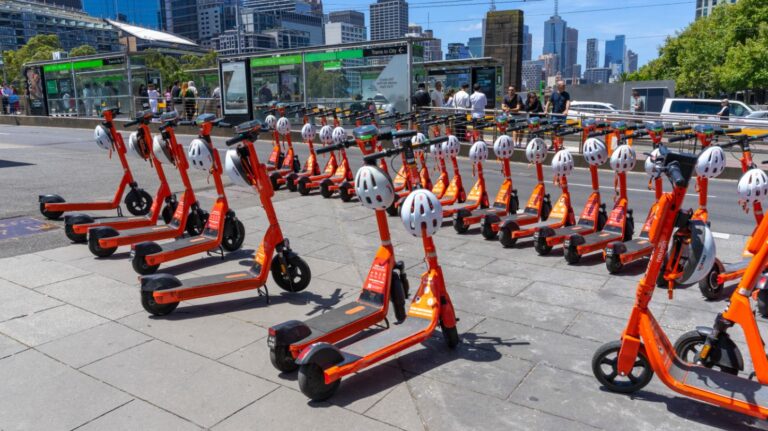Shared e-scooters have safety features that private e-scooters lack, but accident data don’t distinguish between them, nor tell us about the economic and environmental harms of other transport modes.
Melbourne City Council voted to break its contracts with operators of shared e‑scooter schemes this week, citing safety concerns. It seems these concerns have usurped the long-term transport and environmental gains from moving towards sustainable transport. A year ago, the city reported emissions had been cut by 400 tonnes since trials of these e‑scooters began.
Shared e‑scooters only became available to Melburnians in early 2022. But electric scooters have existed for more than a century. They were very popular on public streets in the United States after motorised scooters first appeared in 1915.
However, their use for criminal getaways soon marred their reputation. The opportunity for a lower-emission, more equitable form of transport was lost, until now. It could be lost again because of knee-jerk reactions to concerns about their safety.
In fact, shared e‑scooters have safety features that individually owned ones often lack. Shared e‑escooters cause fewer serious injuries than bicycles or motorcycles, according to New Zealand accident compensation data. In Australia, while there has been a rise in numbers treated in hospitals for e‑scooter injuries, no distinction is made between shared and private e‑scooters.
Private e-scooters greatly outnumber shared ones
Today, an estimated 15,000 shared e‑scooters are in use across Australia and New Zealand. No official figures are available for private e‑scooters, but there are likely to be many more of them.
Segway, a globally dominant maker of e‑scooters, reported it had sold 8.5 million private versus 1.5 million shared e‑scooters by 2022. In the United Kingdom, an estimated 360,000 private e‑scooters were bought in 2020. New Zealand Statistics reports roughly 400,000 e‑scooters were imported from 2018 to 2023.
One can assume, then, that private e‑scooters similarly outnumber shared e‑scooters in Australia. And the distinction between rental and private e‑scooters is an important one in the debate about safety.
Media reports on shared e‑scooters in Melbourne have concentrated on two key subjects: launching trials and safety. Recent coverage refers to significant incidents and injuries. This creates a perception that e‑scooters are much less safe than other transport modes.
Regulated shared e-scooters are safer
The first thing to note is these reports don’t distinguish between shared and private e‑scooters. This matters because the shared e‑scooter market is highly regulated in Australia.
Their operators are required to:
- provide helmets for riders
- apply speed limiters so they don’t exceed safe speeds
- geo-fence e‑scooters to limit where they can travel
- use pedestrian-detection technology.
In contrast, private e‑scooters are not registered. They have different quality specifications and can have larger motors, often exceeding regulated engine outputs that vary from state to state. Importantly, private e‑scooters lack the advanced technologies used on shared e‑scooters to monitor rider use.
There is little to no regulation or quality control over the private e‑scooters Australians can buy. Some models seen on the streets can exceed the legal speed limit. All that’s stopping them speeding is rider responsibility and police oversight.
Hospitals records of e‑scooter injuries do not distinguish between private or shared e‑scooter riders. That’s also true of injury reporting and statistics, due to the way authorities collect crash statistics.
Yet reported injury statistics for New Zealand indicate that the rate of serious injury while using a shared e‑scooter points is lower than for other modes of transport. Far more people suffered soft tissue injuries from rollerskating and skateboarding (5,344) than from riding e‑scooters (1,119), for instance. Nine times as many bike riders incurred a head injury or concussion (681) compared to e‑scooter riders (76).
Better infrastructure is also vital for e‑scooter safety. A 2020 International Transport Federation (ITF) report found 80% of e‑scooter crashes occurred at intersections, and 70% during the day.
The findings are not surprising when scant attention has been paid to delivering safe e‑scooter infrastructure. In Melbourne, for example, some lanes available for e‑scooter riding end abruptly.
E-scooters cut emissions and congestion
The most important issue arising from the City of Melbourne’s ban is the role e‑scooters (and e‑bikes) can play in shrinking cities’ huge carbon footprints. In addition, e‑scooters can:
- reduce traffic congestion
- improve access to public transport
- provide more efficient transport for shorter trips
- remove the need for car parking
- improve air quality.
The City of Melbourne pointed solely at the safety concern to justify its ban. The city instead needs more proactive policies to integrate shared e‑scooters into the its mobility mix. This would have delivered all the public good of this transport mode.
Governance is a neglected issue
Much of the research on e‑scooters in cities focuses on sustainability and safety. Governance (policies, rules and regulations) is largely overlooked.
Operating governance structures are established following a traditional operator licensing pathway. This approach is now being questioned.
What has been lacking is broad engagement with all stakeholders, including the public. The focus should be on balancing the benefits and burdens of shared e‑scooters.
E‑scooters are a particularly valuable form of transport for young people and those on low incomes or with a disability. The social justice they provide has been neglected. Predictably, then, the focus has been on the burdens, including safety.
Another problem is the widely varied approaches around Australia to regulating e‑scooters. There isn’t even a consistent definition of e‑scooters.
It appears governance decisions, which include ending operator licences, aren’t using reliable evidence to avoid knee-jerk reactions.
For widespread sustainable and safe e‑scooter use, there needs to be:
- better governance and rider safety education
- more consistent and specific recording of e‑scooter incident and injury data
- an appreciation that riders are vulnerable road users who deserve safe infrastructure.
A comprehensive, inclusive assessment of benefits and burdens is needed. We may then establish more clearly the sustainability and equity benefits, manage the safety concerns and arrive at more consistent policies and definitions across Australia.![]()
This article is authored by Mark Stevenson, Professor of Urban Transport and Public Health, The University of Melbourne and Ferdinand Balfoort, PhD Candidate in Law, Charles Darwin University. It is republished from The Conversation under a Creative Commons license. Read the original article.





